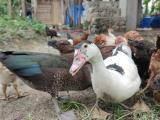Oct 4, 2012
HHS awards $26 million for developing flu antiviral
The Department of Health and Human Services (HHS) has awarded NexBio, Inc, of San Diego a 17-month, $26.5 million contract to develop its antiviral drug Fludase, which "could work against all known flu viruses, including virus strains that are resistant to currently licensed antiviral medications," HHS said yesterday in a news release. The funding, provided by HHS's Biomedical Advanced Research and Development Authority (BARDA), will support a clinical study assessing safety, efficacy, and proof of concept, as well as later clinical studies. Fludase is designed to block influenza viruses from attaching to human cells, thereby preventing infection, HHS said. "The development of new influenza antiviral drugs with novel mechanisms of action is a renewed priority for HHS as a way to address emerging resistance to present drugs, to provide better treatment, and to increase the treatment options for doctors and patients for seasonal and pandemic influenza," said BARDA Director Robin Robinson, PhD.
Oct 3 HHS news release
Study: Flu viruses survive best at high, low humidity
Influenza A viruses (IAVs) survive best at relative humidity (RH) near 100% and lower than 50%, according to a study in PLoS One yesterday that attempted to pinpoint factors that might explain flu's seasonal patterns. US researchers studied the effect of RH from 17% to 100% on IAV viability in (1) various media chosen to isolate the effects of salts and proteins found in respiratory fluid and (2) human mucus. They found that virus viability was highest in all media and in mucus when RH was either close to 100% or below about 50%. When RH decreased from 84% to 50%, however, viability increased dramatically in mucus, decreased in saline solutions, and stayed about the same in solutions supplemented with proteins. The authors said their findings "could help resolve conflicting findings in the literature on the relationship between IAV viability in aerosols and humidity, and results in human mucus could help explain influenza's seasonality in different regions."
Oct 3 PLoS One study
H5N2 reported on South African ostrich farm
Highly pathogenic H5N2 avian flu has struck a South African ostrich farm, infecting 1,286 of 1,930 birds but not causing any deaths, a regional agricultural official said in a report to the World Organization for Animal Health (OIE) today. The outbreak, in Western Cape province near the southernmost tip of the country, began in June, according to the report, but at first the ostriches showed no clinical signs. Culling efforts on the commercial farm have begun.
Oct 4 OIE report



















